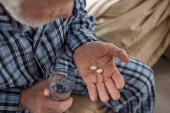Repeat Revascularization Not Increased With Solo Ticagrelor: TWILIGHT Analysis
Operators have been in love with aspirin for a long time, but all signs point to it being time to move on, says Mladen Vidovich.

PHOENIX, AZ—High-risk post-PCI patients on ticagrelor (Brilinta; AstraZeneca) monotherapy following 3 months of dual antiplatelet therapy (DAPT) do not have a higher risk of clinically driven repeat revascularizations or MACCE at 1 year compared with standard DAPT, according to post hoc analysis of TWILIGHT.
“We found that ticagrelor monotherapy was as effective as ticagrelor plus aspirin in preventing clinically driven revascularization in the overall cohort and in select high-risk subgroups,” said Usman Baber, MD (University of Oklahoma Health Sciences Center, Oklahoma City), who presented the findings here at the Society for Cardiovascular Angiography and Interventions (SCAI) 2023 Scientific Sessions.
The need for a second revascularization in the first year was associated with a large and durable risk for subsequent ischemic events, the analysis found, with most of these events being most likely to occur in the first 30 days after the repeat procedure. Patients at high bleeding risk who were on ticagrelor monotherapy also had less major bleeding compared with the DAPT group and about a 20% lower rate of net adverse clinical events (NACE), which was a composite of all-cause death, non-fatal MI, stroke, clinically driven revascularization or BARC 2, 3, or 5 bleeding.
TWILIGHT is one of several recent studies that have focused on aspirin de-escalation after PCI. Some others include STOPDAPT-2, SMART CHOICE, and GLOBAL LEADERS. Recent revascularization guidelines from the American College of Cardiology and American Heart Association also support shorter-duration DAPT.
In a press conference, David A. Cox, MD (Sanger Heart & Vascular Institute, Charlotte, NC), noted that the data from TWILIGHT have moved the field forward.
“But the problem I've always had with the drug is it's so expensive,” he said, adding that many physicians may have questioned whether generic clopidogrel or prasugrel could be used on their own instead of ticagrelor.
The TWILIGHT findings, which should be considered exploratory, cannot be generalized to patients treated with other oral P2Y12 inhibitors, said Baber
Asked if TWILIGHT is changing practice by encouraging ticagrelor monotherapy in appropriate patients, Baber told TCTMD, “I would say it’s kind of all over the place, to be honest.”
He added that an upcoming consensus document aims to explore a variety of proposed strategies ranging from withdrawing aspirin to de-escalation strategies like starting off with ticagrelor and switching to clopidogrel. “I still think most people are probably trying to get 1 year of dual antiplatelet therapy, and the guidelines still recommend that as class I,” Baber said. “All of the other strategies, including aspirin withdrawal or de-escalation, are IIa at best.”
Repeat Revascularization Analysis
The main TWILIGHT trial enrolled 9,006 PCI patients from 187 sites in 11 countries who were adherent to 90 mg ticagrelor twice daily plus aspirin for 3 months and were then randomized to continued ticagrelor plus aspirin or placebo. Almost 40% of patients in each arm had diabetes and the majority of patients in both arms had ACS. Among the main findings were lower rates of bleeding with monotherapy at 12 months and similar risk of death, MI, or stroke compared with DAPT.
The new analysis included 7,039 patients. Clinically driven revascularization occurred in 7.1% of the ticagrelor monotherapy group at 1 year and in 6.6% of the ticagrelor plus aspirin group (P = 0.363). There were no statistically significant differences between groups in rates of TLR, non-TLR TVR, non-TVR, or MACCE.
Twenty-one patients experienced an ischemic event after repeat revascularization. In these patients, 62% of all events occurred within 30 days and consisted of type 1 MI in 30% and stent thrombosis in 29%. The rate of all-cause death in these patients was 14.3%.
Needing clinically driven repeat revascularization was associated with an increased risk of all-cause death, MI, or stroke (adjusted HR 2.92; 95% CI 1.82-4.67), which was most pronounced within 30 days of the repeat procedure (adjusted HR 6.65; 95% CI 3.27-13.5).
In subgroup analyses, patients with diabetes had a greatly increased risk of repeat revascularization compared with patients without diabetes whether they were on ticagrelor monotherapy or DAPT, with no differences between the groups.
Rates of NACE at 1 year after randomization were 12.2% in the ticagrelor monotherapy group and 14.6% in the ticagrelor plus aspirin group (HR 0.83; 95% CI 0.73-0.94), with the reduction driven by less BARC 2, 3, or 5 bleeding, which occurred at rates of 3.4% and 7.1% in the ticagrelor monotherapy and DAPT groups, respectively (HR 0.56; 95% CI 0.45-0.69).
Not Much Love for Aspirin
Baber said the investigators initially predicted that periprocedural MI would be a driver of events in the first 30 days after repeat revascularization. The finding that it was instead primarily type I MI and stent thrombosis was “insightful” and “a bit unanticipated,” he noted.
“It reinforces that these [repeat revascularizations] are important events with prognostic impact,” Baber added.
“I think this is absolutely terrific data and it reaffirms the original findings of TWILIGHT that de-escalating to ticagrelor alone is a safe strategy,” session co-moderator Mladen Vidovich, MD (University of Illinois, Chicago), told TCTMD. “Even more importantly, it is hypothesis-generating and thought-provoking for the design of future trials to improve patient safety and tailor our antiplatelet strategies with new generations of stents on the way.”
Vidovich said operators “have been in love with aspirin for so long” that dropping it is a hard concept for some. As far back as 1996, the CAPRIE study was arguing that long-term clopidogrel therapy for patients with atherosclerotic cardiovascular disease was more effective than aspirin at lowering the combined risk of ischemic stroke, MI, and vascular death, he added.
However, many things have changed over the years that should allow for further serious consideration to how aspirin is being used, Vidovich noted, pointing to better management of hypertension and hyperlipidemia. “Importantly,” he added, “stent technology has gotten so much better, and I think that is moving our target quite a bit.”
Baber said many questions remain with regard to the routine practice of aspirin-free or de-escalation strategies, including standardizing how to proceed if patients on these strategies have an event.
L.A. McKeown is a Senior Medical Journalist for TCTMD, the Section Editor of CV Team Forum, and Senior Medical…
Read Full BioSources
Baber U. Repeated coronary revascularization in high-risk patients treated with ticagrelor monotherapy after PCI: insights from the randomized TWILIGHT trial. Presented at: SCAI 2023. May 19, 2023. Phoenix, AZ.
Disclosures
- TWILIGHT was supported by an investigator-initiated grant from AstraZeneca.
- Baber reports honoraria from AstraZeneca and Boston Scientific.





Comments